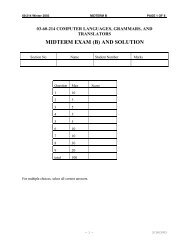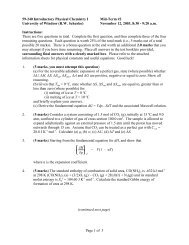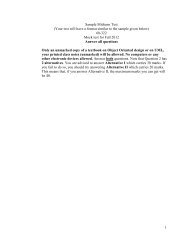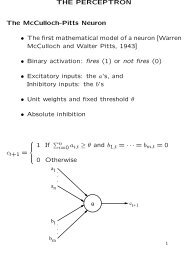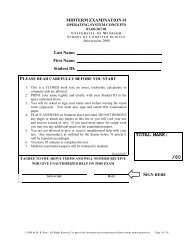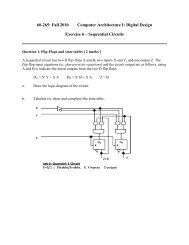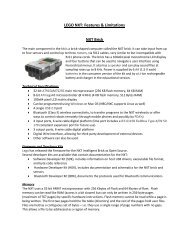LEGO NXT: Features & Limitations
LEGO NXT: Features & Limitations
LEGO NXT: Features & Limitations
Create successful ePaper yourself
Turn your PDF publications into a flip-book with our unique Google optimized e-Paper software.
SensorsOne of the most important components of a robot is the sensor. Much of the <strong>NXT</strong> set’s potential lies inits excellent selection of sensors. The primary purpose of a sensor is to allow the robot to interact withits environment and perform actions based on feedback from its surroundings.This process is called autonomy, which by definition means freedom from external law. An autonomousrobot is a self-governing device that takes input from its sensors and makes decisions based on thisinput.Passive SensorsThe <strong>NXT</strong> set includes three passive sensors: the touch sensor, the light sensor, and the sound sensor.Passive sensors either do not require power from the <strong>NXT</strong> in order to function or do not require the <strong>NXT</strong>to employ a process that rapidly switches between supplying power to and reading the value of asensor.Touch SensorThe touch sensor is useful for a wide variety of applications. The orange missile-shaped tip at the frontend, known as the push button, provides the touch-sensing abilities. When pressed, the push buttonmoves backward into the sensor and completes an electricalcircuit, resulting in a flow of electricity detectable by the <strong>NXT</strong>.When released, the push button springs forward, the circuit isbroken, and the electrical flow stops. Hence, this simpleconfiguration allows for only two possible conditions: pressedor released.Just as the touch sensor can have two different conditions, itcan produce two different values or readings. If the push button is pressed, the <strong>NXT</strong> reads the touchsensor as having a value of 1; if it’s not pressed the <strong>NXT</strong> reads a value of 0. You can use these values in






